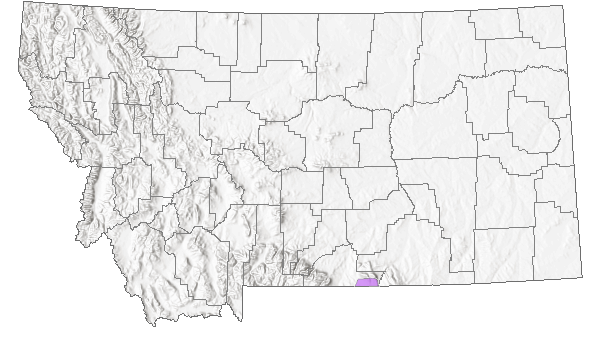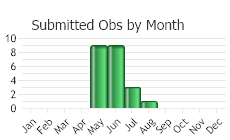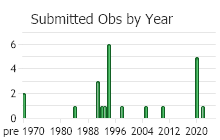View in other NatureServe Network Field Guides
NatureServe
Montana
Utah
Wyoming
Idaho
Wisconsin
British Columbia
South Carolina
Yukon
California
New York
Wind River Milkvetch - Astragalus oreganus
State Rank Reason (see State Rank above)
Wind River milkvetch is a regional endemic known in Montana only from southern Carbon County. Although populations are relatively large, there are few known occurrences in the state and negative impacts or potential impacts to the species from livestock grazing, ORV use, and extractive industries have been noted.
General Description
PLANTS: A low-growing herbaceous perennial with deep, cord-like rhizomes. Stems are 10-20 cm tall, and zig-zag. Source: Lesica et al. 2012.
LEAVES: Pinnately-compound leaves that are arranged alternately on lax stems. Each leaf is comprised of 5-15 obovate leaflets, 5-15 mm long, with blunt to rounded tips. Lower leaf stipules are connate and 5-10 mm long. Foliage is thinly to densely covered with stiff, two-forked (dolabriform) hairs which are appressed to the leaf surface. Source: Lesica et al. 2012.
INFLORESCENSE: Yellowish-white (ochroleucus) flowers are arranged in crowded racemes that arise from the axils of the upper leaves, being barely longer than the leaves. Racemes 3-7 cm long, each with 15-40 flowers. The calyx is united (campanulate) and thinly covered with light-colored hairs. The pea-like flowers have a reflexed upper petal (banner) that is notched at the tip. Source: Lesica et al. 2012.
Phenology
Flowering and fruiting occur in June and July.
Diagnostic Characteristics
Nearly 40
Astragalus species are documented in south-central Montana. Despite this high diversity, few species resemble Wind River Milkvetch.
Wind River Milkvetch –
Astragalus oreganus, SOC
*Stems zigzag. 10-20 cm tall.
*Leaves have 5-15 broadly elliptic to nearly round leaflets (obovate) with blunt to rounded tips, and 2-forked hairs (dolabriform).
*Leaf stipules form a papery sheath at the base of each petiole, completely surrounding the stem (connate), 5-10 mm long.
*Flowers are yellowish-white (ochroleucus), 15-40, crowded in racemes, and cylindrical.
*Flowering stems are barely longer than the leaves.
Low Milkvetch -
Astragalus lotiflorus*Leaves with 5–15 linear-elliptic leaflets with acute tips.
*Leaf stipules lanceolate, 2–5 mm long, and distinct.
*Flowers are arranged in almost sessile racemes with 2–8 spreading flowers.
*Flowering stems are shorter than the leaves.
Canadian Milkvetch -
Astragalus canadensis*Stems do not zigzag, 15-60 cm tall.
*Leaves have 11-23 narrowly elliptic leaflets.
*Leaf stipules are lanceolate-attenuate, 5-10 mm long.
*Flowers 30-100 spreading to declining in crowded racemes.
Species Range
Montana Range
Range Descriptions

 Native
Native
Range Comments
Wind River Milkvetch is a regional endemic species, occurring only in south-central Montana and Wyoming. In Montana it is known only from the Pryor Mountain desert area in Carbon County. In Wyoming it is known from Big Horn, Fremont, and Sweetwater Counties. In the 1964 publication of the Atlas of North American Astragalus, Barneby stated it was locally abundant along the upper Big Horn River and Wind River and also at the edge of the Red Desert in Wyoming (Barneby 1964).
Wind River Milkvetch was first collected by Asa Gray in 1864 on the Wind River in Wyoming. It was not recognized as a distinct species until R.C. Barneby published the Atlas of North American Astragalus in 1964 as Volume 13, Part II in the Memoirs of The New York Botanical Garden (Barneby 1964).
Observations in Montana Natural Heritage Program Database
Number of Observations: 24
(Click on the following maps and charts to see full sized version)
Map Help and Descriptions
Relative Density

Recency



 (Observations spanning multiple months or years are excluded from time charts)
(Observations spanning multiple months or years are excluded from time charts)
Habitat
Across its range in Montana and Wyoming, it occurs in barren bluffs, gullied knolls, dunes, and detritus under cliffs or buttes (Barneby 1964). Wind River Milkvetch grows in sandy, calcareous soil of sagebrush steppe in the valleys of the Pryor Mountain desert portion of Montana. The species forms large colonies in sandy soil below 5,000 feet (Lesica and Achuff 1992). It most often grows in the Chugwater Formation (Lesica and Achuff 1992).
National Vegetation Classification System Groups Associated with this Species
Shrubland
Sagebrush Shrubland
Sparse and Barren
Sparse and Barren
Ecology
ASSOCIATED SPECIESWind River Milkvetch is commonly associated with Big Sagebrush (
Artemisia tridentata), Needle and Thread (
Stipa comata), and Shadscale (
Atriplex cofertifolia) in sagebrush steppe communities.
POLLINATORS The following animal species have been reported as pollinators of this plant species or its genus where their geographic ranges overlap:
Bombus vagans,
Bombus appositus,
Bombus auricomus,
Bombus bifarius,
Bombus borealis,
Bombus centralis,
Bombus fervidus,
Bombus flavifrons,
Bombus huntii,
Bombus mixtus,
Bombus nevadensis,
Bombus rufocinctus,
Bombus ternarius,
Bombus terricola,
Bombus occidentalis,
Bombus pensylvanicus,
Bombus griseocollis, and
Bombus insularis (Macior 1974, Thorp et al. 1983, Mayer et al. 2000, Colla and Dumesh 2010, Wilson et al. 2010, Koch et al. 2012, Miller-Struttmann and Galen 2014, Williams et al. 2014).
Reproductive Characteristics
PAPILIONACEOUS FLOWER
*Species belonging to the Pea Subfamily (Papilionoideae) have papilionaceous flowers (Elpel 2000). This applies to almost all species in the northern latitudes (Elpel 2000), including Wind River Milkvetch.
*Papilionaceious refers to the petals of the flowers that appear like a butterfly.
*The 5 petals (collectively called the corolla) have a bilateral symmetry: large upper petal (banner), two lateral petals (wings), and usually two fused lower petals (keel). The keel petals resembling a boat.
FLOWERS
Calyx: The sepals are united (campanulate; calyx), 6-10 mm long, tipped with teeth (1-3 mm long), and thinly covered with light-colored hairs.
Corolla: Cream-colored (ochroleucus). Banner petal is 10-15 mm, reflexed and notched at the tip. Lateral petals are 13.2-17.6 mm. Keel petal is 10-13 mm.
FRUITS
The fruit is a legume (seedpod). Legumes are fleshy, green, linear-oblong, and 10-16 mm long. In cross-section they are round. When mature, the legumes are nearly erect, leathery, and thinly covered with long soft hairs.
Management
RESEARCH NATURAL AREAS and AREA OF CRITICAL ENVIRONMENTAL CONCERN PROGRAM
The Research Natural Area (RNA) program is a nationwide system created to protect a network of federally administered public lands established for the purpose of scientific research, maintaining biological diversity, and education (USFS 2014). The intent is to designate RNAs that represent the full array of North American ecosystems with their biological communities, habitats, natural phenomena, and geological and hydrological formations. These intact protected areas are managed to maintain their natural and primitive character with a minimum of human disturbance. Each RNA also serves as a baseline of ecological information that can be used to compare against other similar, yet managed ecological systems.
A type of RNA is the Area of Critical Environment Concern (ACEC). The ACEC program was established in the 1976 Federal Lands Policy and Management Act and is managed by the Bureau of Land Management (BLM) (Wikipedia Contributors 2020). Places designated as ACECs require special management to protect important historical, cultural, and scenic values, fish and wildlife, or other natural resources (BLM 2021). The BLM has extended the purpose of RNAs to that of preserving gene pools of typical and endangered plants and animals (BLM 2015; BLM 2021).
Pryor Foothill RNA/ACEC
This RNA-ACEC was established in the Approved Resource Management Plan by the MT/Dakotas BLM, Billings Field Office, recommended for approval by the MT/Dakotas BLM State Director in 2015, and is awaiting final approval by the U.S Congress (BLM 2015). The RNA-ACEC is approximately 2,606 acres in size. The management goals for the Pryor Foothills RNA/ACEC are to protect a large concentration of BLM's special status plant species and rare plant communities (unique vegetation) and to protect significant historic and cultural values in the Gyp Springs area. Large, intact populations of Wind River Milkvetch live in the Pryor Foothill RNA-ACEC. A scattering of populations occur in vicinity of the Pryor Foothill RNA-ACEC. See Range Comments.
The area encompassing Gypsum Creek and Crooked Creek, which includes the present-day Pryor Foothill RNA/ACEC was recognized in 1991 as having the highest concentration of high-priority plant species' populations (Lesica and Achuff 1992). Surveys from the 1980's to 1990's found populations of eight rare species Astragalus geyeri, Astragalus oreganus, Camissonia andina, Cleome lutea, Grayia spinosa, Leptodactylon caespitosum, Malacothrix torreyi, and Mentzelia pumila, of which remain as either Montana Species of Concern or Potential Species of Concern. The area's concentration of unique and diverse plant species partially results from diverse habitats, terrain that varies from highly dissected foothills with deep canyons to broad alluvial valleys, and soils derived from calcareous standstone, Chugwater sandstone, and limestone. In their 1992 report the authors recommended that this area would serve as the best choice for a single reserve in the Pryor Mountain Desert (Lesica and Achuff 1992).
GRAZING
Livestock grazing occurs in some of the areas were Wind River Milkvetch is found. It is thought that the plant is likely unpalatable to livestock. Information on the interaction between Wind River Milkvetch and grazing is needed.
Stewardship Responsibility
Threats or Limiting Factors
In Montana, current and potential long-term threats to Wind River Milkvetch include (Lesica and Achuff 1992; Montana Native Plant Society 2009 and 2021):
Gypsum Mining: Gypsum is a common mineral found in the Chugwater Formation. Gypsum claims have been made on public lands in vicinity of Wind River Milkvetch. Potential negative impacts from mining activities include direct removal and trampling of plants. Potential indirect negative impacts from mining activities include disturbance to habitat from soil erosion, soil compaction, and colonization by invasive species. Soils in the Chugwater Formation are known to be very susceptible to erosion.
Invasive Species: The arid landscape in which Wind River Milkvetch occurs is predominately in native, intact habitat. However, Cheatgrass (Bromus tectorum), African mustard (Malcolmia africans), and Halogeton (Halogeton glomeratus) are known to occur along roads near to some Wind River Milkvetch occurrences. Halogeton outcompetes many native species by increasing the salinity of the soil (Sauer 1988) and has become locally common in the Pryor Mountain Desert region (Lesica and Achuff 1992). There is the potential for negative impacts based on the assumption that these exotics would be more competitive for soil water and nutrient resources, thus displacing native plants.
Off-road Vehicle Recreation: Off-road vehicle (ORV) use commonly occurs further north in Pryor Mountains. In the Big Horn Canyon National Recreational Area one species' occurrence grows along a road and may be vulnerable to vehicular disturbance. Where ORV use overlaps with Wind River Milkvetch populations there is the potential to damage plants by trampling, compacting soils, and increasing erosion.
STATE THREAT SCORE REASON
Reported threats to Montana's populations of Oregon Milkvetch include impacts from existing weed populations, livestock trampling and off-highway vehicle (OHV) disturbance (MTNHP Threat Assessment 2021). Habitat is found on Chugwater Formation substrates, a material that is especially prone to erosion and is known for gypsum rich layers. Surface disturbance in this habitat can directly damage populations and subsequently exacerbate co-occurring threats. Potential surface disrubance in the vicinity of populaitons is a concern where demand for gypsum extraction is ongoing.
References
- Literature Cited AboveLegend:
 View Online Publication
View Online Publication Barneby, R.C. 1964. Atlas of North American Astragalus. 2 Vols. New York Botanical Garden, Bronx, New York. 1188 pp.
Barneby, R.C. 1964. Atlas of North American Astragalus. 2 Vols. New York Botanical Garden, Bronx, New York. 1188 pp. BLM Billings Field Office. 2015. Approved Resource Management Plan Appendices. Billings, MT: U.S. Department of the Interior Bureau of Land Management. 438 p.
BLM Billings Field Office. 2015. Approved Resource Management Plan Appendices. Billings, MT: U.S. Department of the Interior Bureau of Land Management. 438 p. Colla, S.R. and S. Dumesh. 2010. The bumble bees of southern Ontario: notes on natural history and distribution. Journal of the Entomological Society of Ontario 141:39-68.
Colla, S.R. and S. Dumesh. 2010. The bumble bees of southern Ontario: notes on natural history and distribution. Journal of the Entomological Society of Ontario 141:39-68. Elpel, Thomas. 2000. Botany In A Day, Elpel's Herbal Field Guide to Plant Families. 4th Edition, January. Hollowtop Outdoor Primitive School Press, Pony, Montana.
Elpel, Thomas. 2000. Botany In A Day, Elpel's Herbal Field Guide to Plant Families. 4th Edition, January. Hollowtop Outdoor Primitive School Press, Pony, Montana. Koch, J., J. Strange, and P. Williams. 2012. Bumble bees of the western United States. Washington, DC: USDA Forest Service, Pollinator Partnership. 143 p.
Koch, J., J. Strange, and P. Williams. 2012. Bumble bees of the western United States. Washington, DC: USDA Forest Service, Pollinator Partnership. 143 p. Lesica, P. and P.L. Achuff. 1992. Distribution of vascular plant species of special concern and limited distribution in the Pryor Mountain desert, Carbon County, Montana. Unpublished report to the Bureau of Land Management. Montana Natural Heritage Program, Helena, MT. 105 pp.
Lesica, P. and P.L. Achuff. 1992. Distribution of vascular plant species of special concern and limited distribution in the Pryor Mountain desert, Carbon County, Montana. Unpublished report to the Bureau of Land Management. Montana Natural Heritage Program, Helena, MT. 105 pp. Lesica, P., M.T. Lavin, and P.F. Stickney. 2012. Manual of Montana Vascular Plants. Fort Worth, TX: BRIT Press. viii + 771 p.
Lesica, P., M.T. Lavin, and P.F. Stickney. 2012. Manual of Montana Vascular Plants. Fort Worth, TX: BRIT Press. viii + 771 p. Macior, L.M. 1974. Pollination ecology of the Front Range of the Colorado Rocky Mountains. Melanderia 15: 1-59.
Macior, L.M. 1974. Pollination ecology of the Front Range of the Colorado Rocky Mountains. Melanderia 15: 1-59. Mayer, D.F., E.R. Miliczky, B.F. Finnigan, and C.A. Johnson. 2000. The bee fauna (Hymenoptera: Apoidea) of southeastern Washington. Journal of the Entomological Society of British Columbia 97: 25-31.
Mayer, D.F., E.R. Miliczky, B.F. Finnigan, and C.A. Johnson. 2000. The bee fauna (Hymenoptera: Apoidea) of southeastern Washington. Journal of the Entomological Society of British Columbia 97: 25-31. Miller-Struttmann, N.E. and C. Galen. 2014. High-altitude multi-taskers: bumble bee food plant use broadens along an altitudinal productivity gradient. Oecologia 176:1033-1045.
Miller-Struttmann, N.E. and C. Galen. 2014. High-altitude multi-taskers: bumble bee food plant use broadens along an altitudinal productivity gradient. Oecologia 176:1033-1045. MTNHP Threat Assessment. 2021. State Threat Score Assignment and Assessment of Reported Threats from 2006 to 2021 for State-listed Vascular Plants. Botany Program, Montana Natural Heritage Program, Helena, Montana.
MTNHP Threat Assessment. 2021. State Threat Score Assignment and Assessment of Reported Threats from 2006 to 2021 for State-listed Vascular Plants. Botany Program, Montana Natural Heritage Program, Helena, Montana. Sauer, J.D. 1988. Plant migration: The dynamics of geographic patterning in seed plant species. Berkeley, CA: University of California Press. 298 p.
Sauer, J.D. 1988. Plant migration: The dynamics of geographic patterning in seed plant species. Berkeley, CA: University of California Press. 298 p. Thorp, R.W., D.S. Horning, and L.L. Dunning. 1983. Bumble bees and cuckoo bumble bees of California (Hymenoptera: Apidae). Bulletin of the California Insect Survey 23:1-79.
Thorp, R.W., D.S. Horning, and L.L. Dunning. 1983. Bumble bees and cuckoo bumble bees of California (Hymenoptera: Apidae). Bulletin of the California Insect Survey 23:1-79. USDA Forest Service. 2014. Research Natural Areas. Accessed 4 February 2021. https://www.nrs.fs.fed.us/rna/
USDA Forest Service. 2014. Research Natural Areas. Accessed 4 February 2021. https://www.nrs.fs.fed.us/rna/ USDI Bureau of Land Management. 2021. Areas of critical environmental concern. Accessed January 28, 2021. https://www.blm.gov/programs/planning-and-nepa/planning-101/special-planning-designations/acec
USDI Bureau of Land Management. 2021. Areas of critical environmental concern. Accessed January 28, 2021. https://www.blm.gov/programs/planning-and-nepa/planning-101/special-planning-designations/acec Wikipedia contributors. 2020. Area of critical environmental concern. Wikipedia, The Free Encyclopedia. Accessed 27 January 2021. https://en.wikipedia.org/w/index.php?title=Area_of_Critical_Environmental_Concern&oldid=994305208
Wikipedia contributors. 2020. Area of critical environmental concern. Wikipedia, The Free Encyclopedia. Accessed 27 January 2021. https://en.wikipedia.org/w/index.php?title=Area_of_Critical_Environmental_Concern&oldid=994305208 Williams, P., R. Thorp, L. Richardson, and S. Colla. 2014. Bumble Bees of North America. Princeton, NJ: Princeton University Press. 208 p.
Williams, P., R. Thorp, L. Richardson, and S. Colla. 2014. Bumble Bees of North America. Princeton, NJ: Princeton University Press. 208 p. Wilson, J.S., L.E. Wilson, L.D. Loftis, and T. Griswold. 2010. The montane bee fauna of north central Washington, USA, with floral associations. Western North American Naturalist 70(2): 198-207.
Wilson, J.S., L.E. Wilson, L.D. Loftis, and T. Griswold. 2010. The montane bee fauna of north central Washington, USA, with floral associations. Western North American Naturalist 70(2): 198-207.
- Additional ReferencesLegend:
 View Online Publication
View Online Publication
Do you know of a citation we're missing? Dorn, R. D. 1984. Vascular Plants of Montana. Cheyenne, WY: Mountain West Publishing. 276 pp.
Dorn, R. D. 1984. Vascular Plants of Montana. Cheyenne, WY: Mountain West Publishing. 276 pp. Dorn, R. D. 1992. Vascular plants of Wyoming. Second edition. Mountain West Publishing, Cheyenne, WY. 340 pp.
Dorn, R. D. 1992. Vascular plants of Wyoming. Second edition. Mountain West Publishing, Cheyenne, WY. 340 pp. Lesica, P., M.T. Lavin, and P.F. Stickney. 2022. Manual of Montana Vascular Plants, Second Edition. Fort Worth, TX: BRIT Press. viii + 779 p.
Lesica, P., M.T. Lavin, and P.F. Stickney. 2022. Manual of Montana Vascular Plants, Second Edition. Fort Worth, TX: BRIT Press. viii + 779 p. Quire, R.L. 2013. The sagebrush steppe of Montana and southeastern Idaho shows evidence of high native plant diversity, stability, and resistance to the detrimental effects of nonnative plant species. M.Sc. Thesis. Bozeman, MT: Montana State University. 124 p.
Quire, R.L. 2013. The sagebrush steppe of Montana and southeastern Idaho shows evidence of high native plant diversity, stability, and resistance to the detrimental effects of nonnative plant species. M.Sc. Thesis. Bozeman, MT: Montana State University. 124 p.
- Web Search Engines for Articles on "Wind River Milkvetch"





